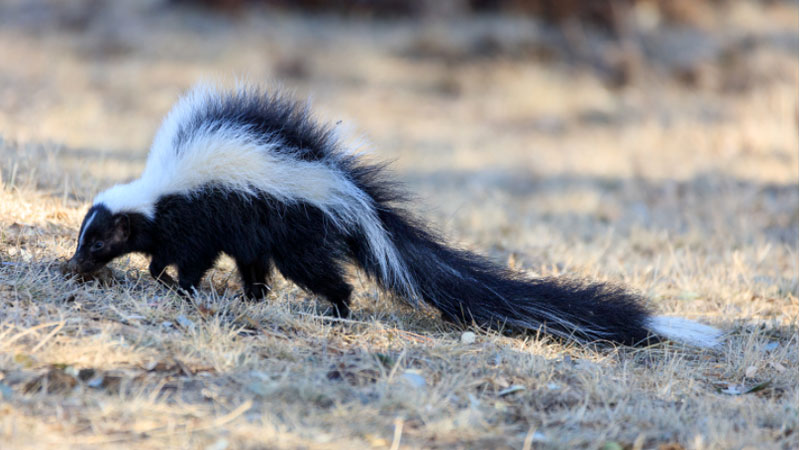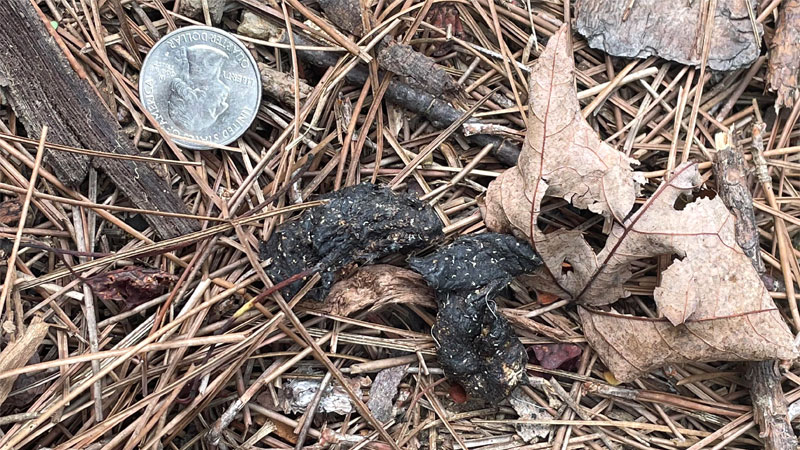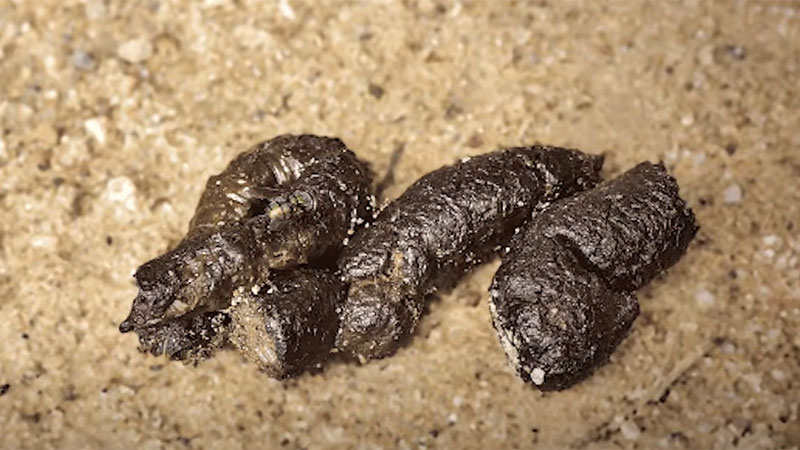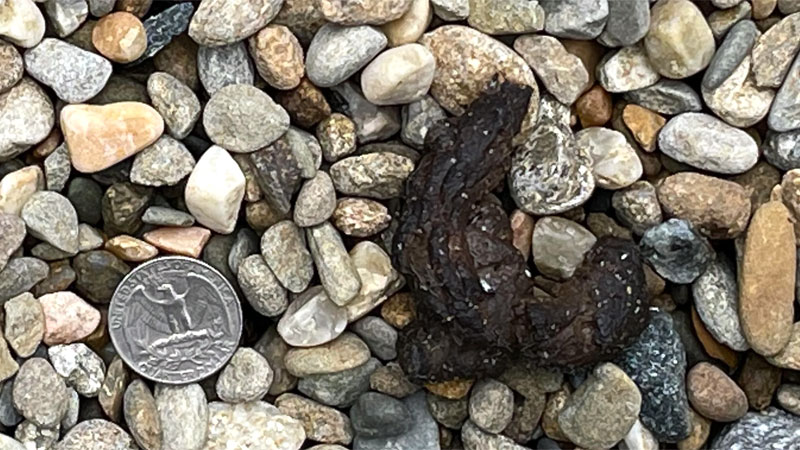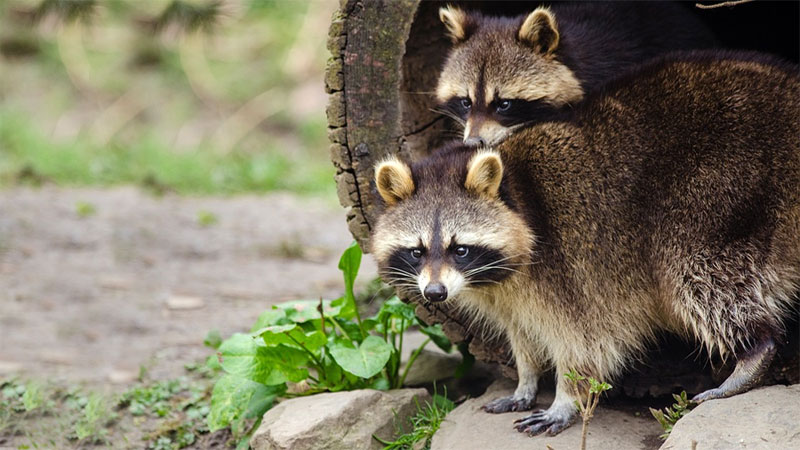Skunks are notorious for their nasty smelling spray, but did you know their droppings can also pose health risks? Here’s how to identify skunk poop and what to do if you find it on your property.
What Does Skunk Poop Look Like?
Skunk droppings have several particular features that can help you identify them:
Shape and Size
Typically tubular and segmented, skunk poop is similar to the droppings of cats or small dogs. The segments may be connected by thinner sections, giving the scat a slightly bumpy appearance.
Normally, skunk droppings are going to be in the 1-2 inch range and about half an inch in diameter. However, like an animal, the actual size can vary depending on the age and size of the skunk.
See Also: Different Types of Skunks in the US
Color and Consistency
Fresh skunk scat is typically black or dark brown in color. As the droppings dry out, they may lighten to a gray or lighter brown-ish color. Skunk droppings are generally firm (not runny), unless the animal is experiencing digestive issues or has consumed a lot of soft foods like berries.
What’s In It?
A good way to help identify skunk poop is looking at its contents. Skunks are opportunistic omnivores, and their diet consists of a variety of foods. Because of that, their feces often contain various undigested items that may include:
- Insect parts, such as beetle exoskeletons or fly wings
- Seeds from berries or other fruits
- Fur or feathers from small mammals or birds
- Traces of plant material, like grass or leaves
Smell
Despite skunks’ notorious reputation for when they spray their victim, their droppings have a much milder scent. Skunk poop may have a slight musky odor, but it’s not nearly as strong or offensive as the animal’s defensive spray. You probably will need to be quite close to the scat to detect any scent at all.
Location
Skunk droppings are commonly found in specific locations, which can help with identification. Skunks tend to defecate in communal “latrines” near their den entrances or in regular feeding areas. These areas may contain multiple piles of scat from different skunks.
Skunks will also leave droppings along well-traveled paths or trails as they move about through their territories.
Skunk Poop vs Other Animal Droppings
| Animal | Size | Shape | Contents | Odor |
|---|---|---|---|---|
| Skunk | 1-2" long, 1/2" diameter | Tubular, segmented | Seeds, insect parts, fur, or feathers | Slight musky odor |
| Raccoon | 2-3" long, 3/4" diameter | Tubular, segmented | Seeds, berries, garbage, or debris | Slight odor |
| Opossum | 1-2" long, 3/4" diameter | Elongated, tubular, slight curve | Fruits, insects, and other soft foods | Mild odor |
| Fox | 2-3" long, 1/2" diameter | Rope-like or twisted, segmented, tapered ends | Fur, bones, or other prey remnants | Slightly pungent |
| Domestic Cat | 1" long, 1/2" diameter | Segmented | Less likely to contain food remnants | Pungent, distinct odor |
| Squirrels, Rabbits, Weasels | Smaller than skunk scat | Round pellets | Varies based on diet | Mild odor |
Are Skunk Droppings Dangerous?
While skunk poop may not seem as concerning as their defensive spray, it can still pose various health risks to both humans and pets. Here are some possible dangers:
Parasites
- Roundworms (Baylisascaris columnaris) – These intestinal worms can cause severe damage to the liver, lungs, and central nervous system if ingested by humans or pets.
- Tapeworms (Taenia spp.) – Skunk droppings may contain tapeworm eggs, which can infect pets if accidentally ingested. Though quite rare, it is possible for humans to contract tapeworms from infected animals.
- Coccidia (link) – These parasites can cause diarrhea, dehydration, and other gastrointestinal issues in animals, particularly young or immunocompromised pets.
Bacterial and Viral Diseases
- Rabies – Skunks are one of the primary carriers of rabies in North America. While the virus is not typically transmitted through feces, skunk droppings can indicate the presence of potentially infected animals in the area.
- Leptospirosis – This bacterial infection can cause severe kidney and liver damage in both humans and animals. Skunks can shed the bacteria in their urine, which can contaminate water sources or soil.
- Canine Distemper – While not a direct threat to humans, canine distemper can be deadly for dogs who have not been vaccinated against it. Skunks can carry and spread the virus, which can be transmitted through contact with infected animals or their bodily fluids.
- Salmonella – Like many other animals, skunks can carry Salmonella bacteria in their digestive system. When they defecate, the bacteria may contaminate the surrounding soil, water, and other surfaces.If humans or pets come into contact with contaminated skunk droppings and then touch their mouth or food, they can contract Salmonellosis.
Odor and Property Damage
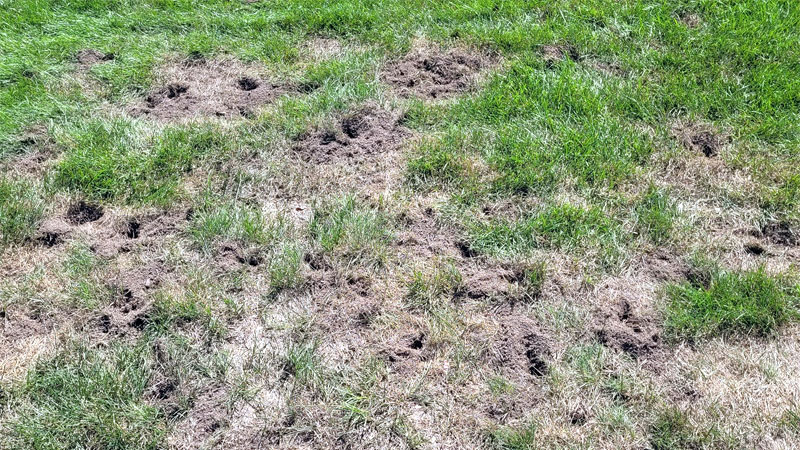
In addition to the health risks above, skunk droppings just smell bad and they can attract other pests to your property. Skunk feces also signal the likely obvious fact that you have one or more skunks living or frequently visiting the area around your home, potentially causing damage to your lawn or garden areas.
Related: 13 Fascinating Skunk Facts
What to Do If You Find Skunk Droppings
If someone in your household finds skunk poop on your property, here’s what I typically recommend:
- Keep pets and children away from the area to prevent accidental ingestion or contact with the droppings.
- Wear disposable gloves and clothing that covers your skin. You may even want to wear a mask.
- Use a small shovel to carefully remove the skunk feces and a bit of soil beneath it that may be contaminated. Place the waste in a sealed plastic bag (grocery store bag works fine).
- Dispose of the sealed bag of skunk scat in your outdoor garbage bin.
- Clean and disinfect the affected area and any tools you used with a solution of 1:10 bleach and water ratio (ie: add 1 ounce of bleach to 10 ounces of water).
- Use preventive measure to discourage skunks from returning. See: How to Get Rid of Skunks
- If DIY methods don’t work as you had planned, contact a professional wildlife removal service to stop skunks from returning.
- How to Identify Skunk Poop (With Pictures) - April 1, 2024
- You Really Don’t Need That Opossum Trap - January 4, 2024
- How to Set a Mouse Trap Without Getting Hurt - December 28, 2023

